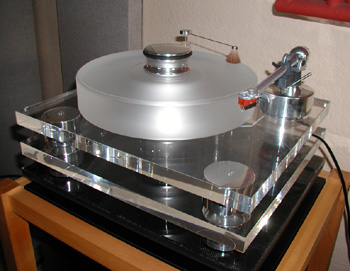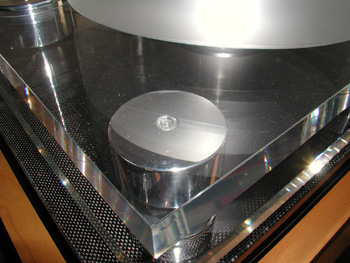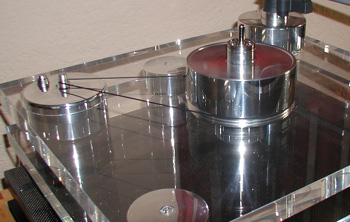You are reading the older HTML site
Positive Feedback ISSUE
4december/january 2003
as reviewed by Dave Clark

DAVE CLARK'S SYSTEM: LOUDSPEAKERS ELECTRONICS SOURCES CABLES ACCESSORIES
|
I will admit that my experience with turntables has been limited to owning; an original AR-XA some 20 years ago (mounted with the venerable Shure V-15 cartridge), which was then replaced by a Sony PX500 thing that featured an arm designed to adjust for tracking warped records through a servo-type system (seemed like a good idea—wished I had kept the AR, though I did hold onto the Shure V-15 to use on the Sony, which was later upgraded to the MR version), which was easily supplanted by a LINN Axis table outfitted with the Basic Plus arm and K9 MM cartridge (a decent but somewhat darkish sounding cartridge); to reviewing a while back, the BASIS 1400 with the Rega RB250 arm and Benz Glider 2 MC cartridge (see www.positive-feedback.com/Issue2/basis.htm), and now the Transrotor Leonardo (with their modified Rega arm—looks like a 300, but it does not say whether it is the 250, 300, 600, or whatever, so you will have to take my word for it).
Okay so my experience is limited to a few tables, but what I have heard sort of runs the gamut from the early benchmark of the belt-drive to its latter incarnation in the entry-level LINN and BASIS tables to the direct-drive Sony (not inexpensive at the time—early 80s and the table ran a little over $500 retail—it was I believe one of Sony’s forays into the higher-end). But of all the tables I have heard the Transrotor Leonardo is by far the best of the lot! Yes I am letting the cat out of the hat, but this table is a real killer and easily shows just how much better analog is than the better red-book playback systems—like mine!
I will also admit that I do not play that much analog. It is not that I do not play or buy vinyl—I do, it is just that so much comes out on CD (which is especially an issue with our alternative to what is considered alternative taste in music—it is difficult enough finding the titles we like on CD, let alone LP). And truth be told, I am lazy! Hey, a CD lasts for 60 minutes or more and vinyl requires me getting up every 20 minutes or so and flipping the LP over to hear the rest. I need to conserve my energy for sitting on the couch and drinking beer! So while I do own over 500 LPs, we do not spend a lot of time spinning them for our fill in music. But when we do... well the Transrotor really makes us smile!
Let me digress here a bit by getting into the nitty gritty of that table itself. The numbers of the Leonardo 25/25/60 doppio relate to the thickness of the two plinths, each being 25 cm thick and the 60 refers to the platter being 60 cm thick. The term doppio signifies two plinths. The top and bottom plinths sit (or stack) on three "feet" that have little nipples at the top-center and a ring on their bottom of some rubber-like material. These "feet" or cylinders are machined with a hollow base and are said to be a product of "form following function." That is they are designed to suppress resonances or whatever that would interfere with the table getting the music out of the grooves. The motor housing has the same material rimming its base and sits on the bottom plinth through a cut-out in the top plinth. No doubt this helps to minimize motor noise making its way to the stylus.

See the little rubber nipple in the center?
The table comes with a Transrotor modified Rega RB 300 arm. Featuring an improved bearing assembly, counter weight, and internal wiring, the arm has the fit and finish reflective of the table as a whole. The arm comes pre-mounted and allows for minute VTA adjustment via a set-screw on the arm’s base. One can also buy a quite hefty, yet beautiful clamp—a misnomer here as it really sits on the platter as opposed to clamping onto the spindle—that is also engineered to address resonances. A mounted record brush is also an option, which is beneficial in cleaning out any dust and whatnot residing on your LPs as they spin. The downside of this is that the purist may find the brush adding a bit of static charge to the LP as it spins. I am not sure about this issue, as the brush appears to be fine hair from some animal and not synthetic. If so, perhaps this is a moot point, then again perhaps not. All in all, once "assembled" the table is a very solid and quite stunning to look at! There is an ever-so-slight give and take to the table when pushed (the "rubber" like contacts points) which appeared to impart no audible liability to the music. I do have suspended wood floors and full-range speakers (pretty flat to 25Hz in my room) and the table never showed to least in rumble or noise from either footfalls of the music being played. Even so I decided to place a Black Diamond shelf with #3 BDR cones between the table and the rack. Looked really slick (I'll be honest and admit to being an audio-geek at heart) and added just that much more isolation, though sonically the differences were too slight to make an issue out of! Hey, I guess the Transrotor design is doing its thing.
But before I go any further, let me get one thing out of the way. In looking at the table one is going to do quick double take and say, "Hey, that looks familiar!" "Wait a minute... that looks like the Champion line from Clearaudio!" "They’re copying Clearaudio!"
I am sure Transrotor would say that it is the other way around. But I am not going take sides here, even though the US importer tells me that Transrotor has been around much longer (one of the oldest table manufacturers in the world as well as building tables for other table companies) and they are the ones being "copied" and not vice-versa. Where the truth lies is no doubt somewhere in the middle as I am sure Clearaudio has their side to the story. Regardless, the two lines do have much in common design-wise, so something is going on here. Perhaps each has come to the same conclusion that this is the better way to design a turntable, though there are a few minor differences between the two – some of which may not be so minor in terms of their affect on the table’s performance.
First off the tables use different materials for the plinths and support feet. Clearaudio uses fixed feet that "bolt" to the plinths meaning the plinths operate as one solid unit. This is in opposition to that of Transrotor who stack the plinths with "feet" as described above. Clearaudio has opted for a black "acrylic" material for the plinths, while Transrotor uses a clear material—of which I have no clue as to either’s true composition, other than they appear to be different based on not only by what one hears when tapping their surface, but by fit and finish—the Transrotor is nicer. Last is the issue of how the platter gets its rotation. On the Transrotor, the belt turns the platter from the underside via a grooved aluminum sub-platter that is part of the spindle assembly. This sub-platter is about half the size of the platter the record sets on and is not insignificant in mass. Clearaudio opts to turn the platter by a belt running around its circumference. Not having a Clearaudio in house, I cannot report on the superiority of either, so I can only assume that Transrotor felt that the added expense of a machined aluminum sub or inner-platter was the better alternative to the belt ridding the outer circumference of the platter. I would think that by going under the platter to a smaller diameter "pulley" would put less stress on the spindle and bearing, while also allowing the platter to have less contact with the motor assembly, resulting in a quieter and more "stable" background.

The motor spindle has grooves for 45 and 33 1/3 and is activated by a small button on its surface for on/off. Power to the motor is via an external 18 volt AC module.
Now to make matters really interesting, I am using a Clearaudio cartridge—the Virtuoso MM with the wood body to be exact. Since the Transrotor has so much in common with the Clearaudio tables, it would also seem to make sense that it would work with this table, and so it does! This is a killer cartridge and an ideal match for my system (see www.positive-feedback.com/Issue1/theaudioanalyst.htm) mating well with the E.A.R. 834 phono-stage–hard to beat unless you want to spend WAY more money. So what this means is that the table is being heard as part of a complete analog playback system. Therefore, I am not reporting on just how the table sounds, but how the table combined with the cartridge feeding the 834 sounds when spinning LPs. One also has to consider interconnects and any platform placed under the table. In this case I used the DH Labs Revelations from the 834 to the BC3000 and the BDR shelf as mentioned above. The 834 has been modified with Hovland caps and is feed AC via a Blue Circle BC61 power cord from an Audio magic Stealth.
How does it sound playing back vinyl? Like I said, killer! This analog rig so far superior to my digital set-up, that it is sad how little digital technology has really come sonically. Digital is very good, and the Cary is right up there with the best. But compared to the Cary 306/200 (see the review www.positive-feedback.com/Issue2/cary306.htm and mods article www.positive-feedback.com/Issue2/carymods.htm) feeding the latest active version of the Taddeo Digital Antidote Two all using the DH Labs Revelations interconnects, the differences are so dramatic as to be almost funny. Priced at about the same level as complete playback systems, the Transrotor has it over digital-rig in terms of ambiance, pace, dynamics, tonality, presence, and that sense of "wholeness" where the music is just one complete "entity" as opposed to individual bits and pieces.
Heck even bass dynamics and slam (include the quality and quantity of the bass as a whole), which is a definite strength of the Cary, was equaled by the Transrotor set-up. Bass was tight and deep with no smear, boom, or bloat as I was used to hearing from the LINN. The LINN added a bit too much warmth and richness to the lower midrange and on down, making music a bit too full and lush. Nice, but the Transrotor is in another league. The Basis also revealed this trait in the LINN, itself being tighter and faster in the bass, but to its detriment it erred in loosing a degree of musicality when one moved higher up in the frequencies—say from the upper mids and on up. This resulted in the Basis coming across as a bit mechanical and leanish sounding. Nothing too serious, but enough that I stilled preferred the LINN. The LINN was simply more musical, though perhaps with a touch of "color" or added oomph when compared to the Basis. I believe I described the Basis’s bass sounding pretty much as it looked—lean, clean, and mean. The Transrotor has a similar look and feel aesthetically, but does not err in this direction. Even though the bass is deep and powerful (and lean, clean, and mean), the music is well balanced harmonically and sonically, without any apparent hills or valleys in the frequency range. At least none that I heard in my room with my aging ears (recently tested and have very good hearing for someone approaching 50!). It is as musical as all get out!
The Transrotor rig is also dead quite with so little groove noise that unless the record is rather well-played, it rivals that "emptiness" heard from the Cary. Music comes from a dead quite background or "blackness" resulting in a wealth of musical texture and ambiance. This shows itself in the sense of "space" one can hear from recordings that feature minimal miking. Playing a sampling of releases from a Lambchop and Low (which allowed me to compare with the Cary since I have the same titles on LP and CD), the Transrotor revealed a greater sense of interplay between the musicians along with less "artificiality" as heard from the Cary. I mean, this is a playback system, and not the real thing! With digital, it never sounds like the real thing, close, but no cigar. The Transrotor though, made this fact that less evident—it was still a recording and not the real thing, but with LPs spinning on the Transrotor, music just kicked in with so much more "musicality" and "naturalness," that I am now not only listening to more LPs, but I am also buying more LPs! Who cares if ain't the the real thing when it's this good?!
While the LINN has the notorious trademark of being the leader in pace and drive—you know, the feeling that the music is moving along like a fine-tuned car and all you want to do is get into the groove, say rhythm—I think that the Transrotor has the LINN so easily out classed here that the differences are rather comical. Of course this is a $3500 table versus a $1200 table, so one would expect to get something more for their money. And you do! The LINN was a very competent player and still serves someone well. But the Transrotor simply allows so much more rhythmic drive and musical information to reach the listener—no doubt an issue of its dead quite character that imparts so little into or onto the music. Pace wise, the Basis offered a fast and clean sound with plenty of detail, but again it came across as a bit too white and bland harmonically. But the Transrotor comes across with all the pace, rhythm and drive you can handle without giving up the musicality in the grooves. This may be an issue of comparing, not only a more thought out table versus one that is "entry-level", but a moving coil versus moving magnet cartridge (Virtuoso MM versus the Benz Glider Series 2 MC cartridge as used on the Basis as well. Yes MM and MC cartridges possess different sonic characters, but the Virtuoso, based on the press it has received so far, is no slouch and has been claimed to one of the better cartridges under a couple of grand. But how much of the differences are dependant on the two cartridges I can not say.)
Playing the same Lambchop and Low LPs plus a few other well chosen titles—Tom Waits' latest two for example—one also has a much greater appreciation of the instrumental "texture" that can be heard on exceptional well-done recordings, allowing one to hear all the little things going on. Guitars and percussion come across with all the subtle nuances that had previously been glossed over or lost in the translation. Especially as presented by the LINN which was more opaque, and to less degree by the Basis which tended to be too transparent by accentuating the details to degree that was a bit too much. True, via the Cary I can hear these just as well, but as played back from the LP spinning on the Transrotor, they come across with more of that je ne sais quoi that separates the best from the rest. Things just sound sooo good and tangible!
Now like I said earlier, all I can report on is how the Transrotor sounds as a system here and not as an individual table. As a system, it sounds really, really good and easily betters anything I have heard here so far—analog or digital. How good is it compared to other tables costing the same or more? Heck if I know. I can only assume that more money may buy you more of what the Transrotor does well and less of it faults—of which I am hard pressed to find any, if at all. On the other hand a different table may just sound different, as would the Transrotor fitted with a different cartridge. I do know this; I bought the table as reviewed and am quite happy. Highly recommended.
Leonardo 25/25/60 doppio
Retail: $3500 w/arm
Transrotor
web address: www.transrotor.de
Axiss
Distribution
TEL: 310. 329. 0187
web address: www.axiss-usa.com
